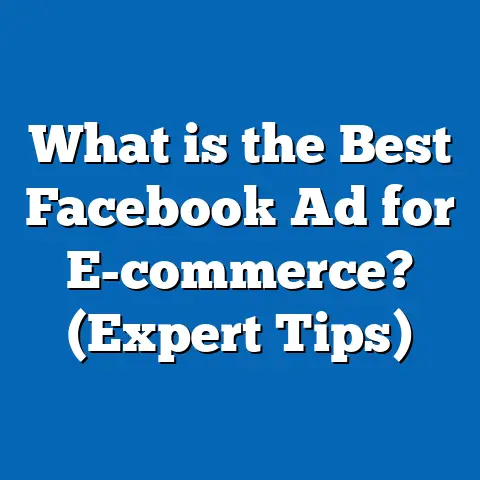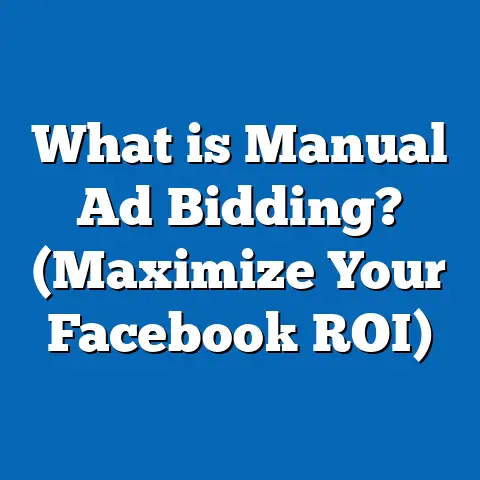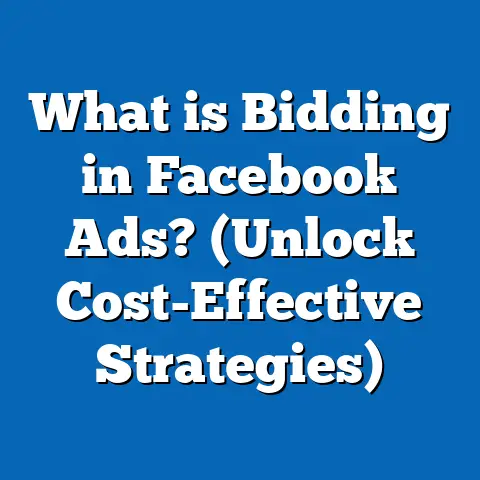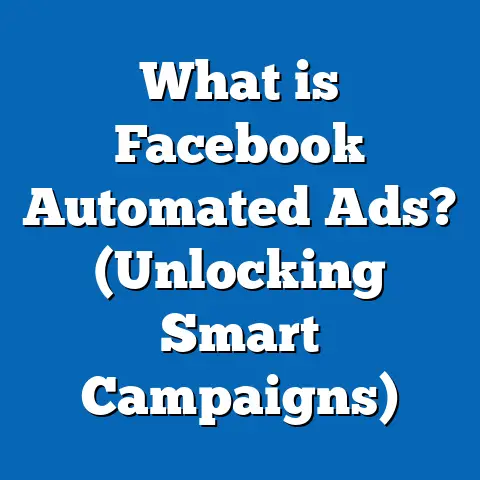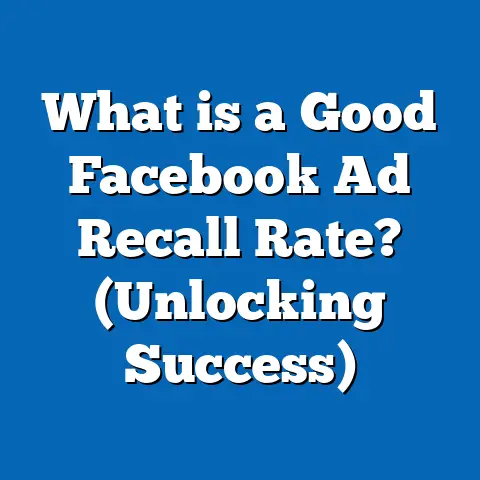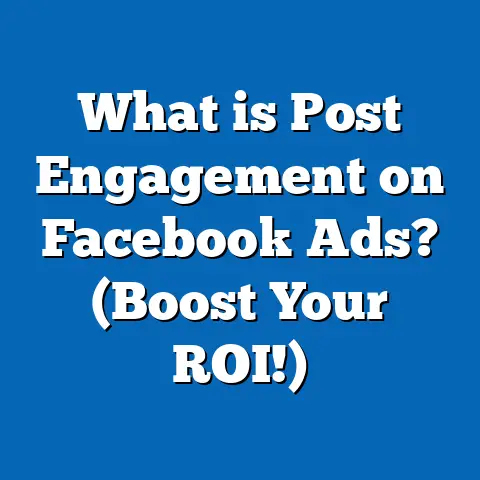What is a Good Facebook Ad Result Rate? (Unlocking Success)
Introduction: The Irony of Facebook Ad Success Metrics
Isn’t it ironic how advertisers obsess over Facebook ad results, yet many don’t fully understand what “good” really means? Marketers pour thousands of dollars into campaigns, scrutinizing every click and impression, hoping for magical numbers that validate their efforts. Yet, the elusive “good Facebook ad result rate” often remains a mystery—a moving target influenced by goals, industries, and evolving platform algorithms.
Facebook advertising has become a cornerstone of digital marketing strategies worldwide. Its vast user base of over 3 billion monthly active users offers unparalleled reach and targeting precision. However, the complexity of Facebook’s advertising ecosystem often leaves marketers puzzled about what success looks like. What is a “good” click-through rate (CTR)? How do you interpret conversion rates across different industries? Should you focus on engagement or direct sales? This guide will answer these questions in detail.
We’ll break down the terminology, share data-backed benchmarks, reveal how to interpret results in ways that drive real business outcomes, and highlight actionable strategies to improve your Facebook ad performance. Whether you’re a marketing pro or a business owner, mastering this will unlock your path to consistent advertising success.
Understanding Facebook Ad Result Rates
What Does “Ad Result Rate” Mean?
In the world of Facebook ads, “result rate” refers to how effectively an ad achieves its intended goal relative to the audience that saw it. Facebook offers several key metrics that advertisers use to measure success:
- Click-Through Rate (CTR): Percentage of people who clicked your ad after seeing it.
- Conversion Rate: Percentage of those clicks leading to a desired action (purchase, signup, download).
- Engagement Rate: Percentage of people who interacted with your ad (likes, shares, comments).
- Cost Per Result (CPR): How much you pay for each action.
- Return on Ad Spend (ROAS): Revenue generated for every dollar spent on ads.
Each of these reflects a different aspect of ad effectiveness. To understand what a good result rate is, you must first understand the purpose of your campaign.
Why Result Rates Vary by Campaign Goal
Facebook Ads Manager allows advertisers to select campaign objectives such as awareness, consideration, or conversion. Each objective optimizes for different behaviors:
- Awareness campaigns optimize for impressions or reach.
- Consideration campaigns optimize for engagements or clicks.
- Conversion campaigns optimize for sales or leads.
The “good” result rate for an awareness campaign (e.g., impressions or reach) will differ greatly from one focused on conversions.
How Facebook Defines “Results”
Facebook’s own reporting defines “results” as the actions your ads drive that align with your campaign objective. This means your measured result rate is inherently tied to your chosen goal and the optimization method Facebook uses behind the scenes.
Why Facebook Ad Result Rates Matter
The Business Impact of Good Result Rates
High ad result rates mean more efficient use of your advertising budget. Better CTRs and conversion rates translate directly to higher sales or leads without increasing spend. This efficiency enables marketers to scale campaigns profitably.
For example, increasing CTR by just 0.5% may reduce the cost per click (CPC), allowing you to acquire more potential customers within the same budget. Similarly, improving conversion rates means more revenue from the same traffic volume.
The Cost of Ignoring Result Rates
Ignoring these metrics can lead businesses to continue pouring money into ineffective campaigns. According to WordStream’s 2023 data, the average CTR across all industries on Facebook is about 0.90%. Campaigns performing below this benchmark may be underperforming drastically.
Moreover, unmonitored campaigns can waste budgets on irrelevant audiences or poorly crafted creatives. This can lead to negative brand perceptions and missed growth opportunities.
How Result Rates Influence Algorithmic Optimization
Facebook’s ad delivery system relies heavily on machine learning algorithms that optimize based on early signals like CTR and conversion rate. Higher-performing ads get better placement and lower costs over time. Poor result rates can cause your ads to be shown less frequently or at higher costs.
Benchmarks: What Does a Good Facebook Ad Result Rate Look Like?
Detailed Average CTR Benchmarks by Industry
CTR is one of the most commonly used metrics because it reflects immediate audience interest.
| Industry | Average CTR (%) | Notes |
|---|---|---|
| Retail | 1.59 | Highly competitive space |
| Finance | 0.56 | More cautious audience |
| Education | 0.73 | Lower CTR but high-value leads |
| Technology | 1.04 | Tech-savvy audience |
| Health & Wellness | 1.04 | Engaged demographics |
| Travel & Hospitality | 0.90 | Seasonal fluctuations |
| Real Estate | 0.99 | Highly localized targeting |
(Source: WordStream 2023)
Why CTR Varies Across Industries
Industries like retail benefit from impulse purchases often driven by attractive visuals and offers, leading to higher CTRs. Finance or legal sectors may see lower CTRs because users are more cautious and require more trust-building before clicking.
Conversion Rate Expectations
- Average Facebook conversion rates range between 9% and 10% across industries.
- E-commerce often sees lower conversion rates (~2-3%) but high volume.
- B2B campaigns tend to have higher conversion rates (~10-15%) on lead generation.
- Mobile app install campaigns typically have conversion rates around 5%.
Engagement Rate Insights by Content Type
Engagement reflects how users interact beyond just clicking:
- Video ads typically achieve engagement rates between 6% and 12%.
- Image ads average around 3-5%.
- Carousel ads usually perform slightly better than single images due to interactive format.
- Poll ads and interactive story ads can exceed 15% engagement but depend heavily on creative quality.
Cost Metrics: CPR and ROAS Benchmarks
- Average Cost Per Click (CPC) on Facebook ranges from $0.50 to $2.00 depending on industry.
- Cost Per Acquisition (CPA) varies widely; e-commerce averages $10-$30, while finance can go up to $50-$100.
- A ROAS of 4:1 or higher is generally considered profitable in e-commerce.
Factors Influencing Facebook Ad Result Rates
Audience Targeting
Targeting is crucial to relevance:
- Narrow targeting focuses on specific demographics, interests, or behaviors, improving relevance and boosting CTR and conversions.
- Broad targeting can increase reach but dilutes message relevance and lowers engagement.
Facebook’s targeting options include custom audiences (website visitors, email lists), lookalike audiences (similar users), and detailed interest/behavior targeting.
Ad Creative Quality
Creative quality includes visuals, copywriting, layout, and call-to-action:
- Ads with clear value propositions outperform vague messaging.
- High-quality images or videos attract attention in crowded feeds.
- Emotional storytelling tends to increase engagement.
- Strong CTAs drive higher click-through and conversion rates.
Ad Placement
Placement impacts visibility and interaction:
- News Feed ads have higher CTR but also higher CPC due to competition.
- Stories ads have immersive full-screen experience but shorter attention spans.
- Audience Network extends reach beyond Facebook but may yield lower engagement.
Testing placements allows advertisers to find where their audience is most responsive.
Campaign Objective Alignment
Choosing correct objectives in Facebook Ads Manager is essential:
- Use Traffic objective when focusing on visits but not conversions.
- Use Conversions objective when driving sales or signups.
- Use Engagement objective when boosting social proof through likes/comments.
Mismatch between objective and creative reduces result rate.
Seasonality and Market Trends
Advertising results fluctuate with seasonality:
- Q4 holiday campaigns face higher competition but increased buyer intent.
- Summer months may see lower engagement in some industries.
- Events like Black Friday often yield peak ROAS.
Keeping calendar-based trends in mind helps optimize budgets and creative timing.
Case Studies: Real-World Facebook Ad Result Rates
Case Study 1: E-Commerce Fashion Brand Boosts CTR by 45%
A mid-sized fashion retailer targeted women aged 18-34 with video ads showcasing new arrivals. They used sequential retargeting showing product benefits after initial interest.
After refining targeting and refreshing creatives monthly:
- CTR increased from 0.75% to 1.09%.
- Conversion rate rose from 2% to 3.5%.
- ROAS improved from 3:1 to 5:1.
- Cost per purchase decreased by 25%.
Key takeaways:
- Regular creative refresh prevents ad fatigue.
- Sequential messaging nurtures prospects through funnel.
- Precise audience segmentation improves relevance.
Case Study 2: B2B SaaS Company Improves Lead Quality
Initially running Traffic campaigns aimed at website visits yielded low-quality leads with a conversion rate under 5%. They switched their campaign objective to Lead Generation using Facebook’s Lead Ads format with educational whitepapers offered.
Results after three months:
- Conversion rate increased from 8% to 14%.
- Cost per lead decreased by 30%.
- Engagement rate doubled due to relevant content.
- Sales team reported higher lead quality leading to better close rates.
Key takeaways:
- Align campaign objective with business goals for better optimization.
- Educational content builds trust in B2B environments.
- Lead Ads reduce friction in form completion.
Case Study 3: Nonprofit Organization Raises Awareness Efficiently
A nonprofit focused on increasing awareness about environmental causes ran awareness campaigns optimized for reach.
Metrics showed:
- Impressions reached over 1 million users.
- Engagement rate averaged 4%, above average for awareness campaigns.
- Website traffic from social increased by 20%.
Although direct conversions were low (expected for awareness campaigns), the nonprofit successfully elevated brand visibility cost-effectively.
Key takeaways:
- Awareness campaigns focus on reach rather than direct sales.
- Engagement can be a secondary success metric.
- Campaign goals dictate interpretation of result rates.
Comparing Facebook Ad Results With Other Platforms
| Platform | Average CTR (%) | Average Conversion Rate (%) | Typical ROAS |
|---|---|---|---|
| ~0.90 | 9-10 | 4:1 – 6:1 | |
| Google Ads | ~3.17 | 3-5 | 2:1 – 4:1 |
| ~0.80 | Similar to Facebook | Slightly higher | |
| ~0.39 | ~15 | Higher for B2B | |
| TikTok | ~1.24 | Lower (~2%) | Emerging |
Why Google Ads Has Higher CTR But Lower Conversion Rate?
Google Ads targets users actively searching with high intent, driving stronger click interest—but conversions may vary due to competition and landing page experience.
Facebook’s strength lies in discovery marketing through social connections and interests, leading to more engaged audiences but lower immediate CTRs compared to search ads.
Advanced Tips to Improve Facebook Ad Result Rates
Use A/B Testing Methodically
Test one variable at a time—such as headlines, images, CTAs—to isolate what drives performance improvements.
Examples:
- Headline testing: Urgency vs. benefit-driven copy
- Visual testing: Product-focused vs lifestyle imagery
- CTA testing: “Shop Now” vs “Learn More”
Track results over time and scale winners accordingly.
Leverage Facebook Pixel and Conversion API
Installing Facebook Pixel on your website allows you to track actions like purchases and signups accurately. Conversion API complements Pixel by sending server-side event data for more reliable measurement post-iOS privacy changes.
This data helps optimize campaigns towards conversions rather than just clicks or impressions.
Optimize for Mobile Experience
Since over 90% of Facebook users access via mobile devices:
- Ensure landing pages load quickly (<3 seconds).
- Use responsive design for all screen sizes.
- Simplify forms and checkout processes for easy mobile use.
Mobile optimization reduces drop-offs after ad clicks, improving conversion rates significantly.
Utilize Lookalike Audiences
Lookalike audiences are created based on characteristics of your best customers or converters. They allow advertisers to reach new users likely to behave similarly.
Best practice:
- Use high-quality source audiences (e.g., purchasers in last 180 days).
- Test different lookalike sizes (1% – most similar; up to 10% – broader).
- Combine lookalikes with interest targeting for refined reach.
Lookalikes often outperform cold audiences in engagement and conversions.
Retarget Abandoned Carts and Website Visitors
Retargeting users who have interacted with your business but did not convert typically results in higher conversion rates—often between 10%-15%.
Strategies include:
- Dynamic product ads showing items left in cart.
- Incentives like discounts or free shipping offers.
- Sequential messaging nurturing users progressively toward purchase.
Retargeting maximizes ROI by focusing spend on warm prospects.
Measuring Success Beyond the Numbers
Qualitative Insights Matter
While numbers tell a big part of the story, qualitative analysis adds depth:
- Analyze user comments for sentiment and objections.
- Review customer feedback post-purchase for insights into ad messaging effectiveness.
- Conduct surveys asking how customers found your brand.
These insights help refine creative strategy beyond raw metrics.
Attribution Models Affect Perception
Understanding how you credit conversions is vital:
- Last-click attribution: Gives all credit to final touchpoint; may undervalue Facebook’s role if it was an earlier touchpoint.
- Multi-touch attribution: Distributes credit across multiple touchpoints; provides fuller picture but harder to implement accurately.
Facebook Attribution Tool helps visualize user journeys across devices and channels.
Current Trends Impacting Facebook Ad Result Rates
Increased Privacy Regulations
Apple’s iOS updates limit tracking capabilities (App Tracking Transparency). This affects data accuracy for conversion tracking and retargeting efforts, potentially increasing costs per acquisition as targeting precision decreases.
Advertisers need diversified data strategies including first-party data collection and server-side tracking (Conversion API).
AI-Powered Optimization Tools
Facebook increasingly automates budget allocation, audience targeting, and creative delivery using AI algorithms:
- Campaign Budget Optimization (CBO) automatically distributes spend across ad sets based on performance.
- Automated placements help find best-performing channels without manual adjustments.
Advertisers should monitor but also provide clear signals through high-quality creatives and consistent testing.
Growth of Video Content
Video content continues to dominate:
- Video ads generate up to twice the engagement of static images.
- Short-form videos (<15 seconds) perform best in capturing attention quickly.
Advertisers should prioritize video formats like reels and stories aligned with consumption habits.
Practical Next Steps & Recommendations
To capitalize on what defines a good Facebook ad result rate:
- Set Clear Objectives: Define what success means—traffic, leads, sales—and choose matching campaign objectives.
- Benchmark Your Metrics: Regularly compare your CTR, conversion rates, CPR against industry standards presented here.
- Test Creatives Frequently: Refresh visuals & copy monthly; run A/B tests systematically.
- Invest in Data Tracking: Implement Facebook Pixel & Conversion API for accurate measurement & optimization.
- Refine Targeting: Use custom & lookalike audiences; exclude irrelevant groups.
- Leverage Retargeting: Deploy dynamic retargeting campaigns focusing on cart abandoners & engaged visitors.
- Prioritize Mobile Optimization: Ensure fast-loading mobile-friendly landing pages.
- Stay Updated: Monitor platform changes such as privacy rules & new ad formats; adjust strategies accordingly.
Conclusion: Unlocking Success With Facebook Ad Result Rates
Understanding what constitutes a good Facebook ad result rate is essential but complex—it varies based on industry, campaign goal, audience targeting, and creative approach. By grounding your expectations in industry benchmarks, aligning objectives properly, optimizing continuously with data-driven insights, and adapting to platform changes proactively, you can unlock consistent advertising success on Facebook.
Remember: numbers alone don’t tell the full story—qualitative insights and strategic context matter equally in interpreting results meaningfully. Take control of your metrics today to build smarter campaigns tomorrow.
If you want me to prepare supporting visuals like charts or templates for tracking your Facebook ad results against benchmarks from this guide—just ask!

